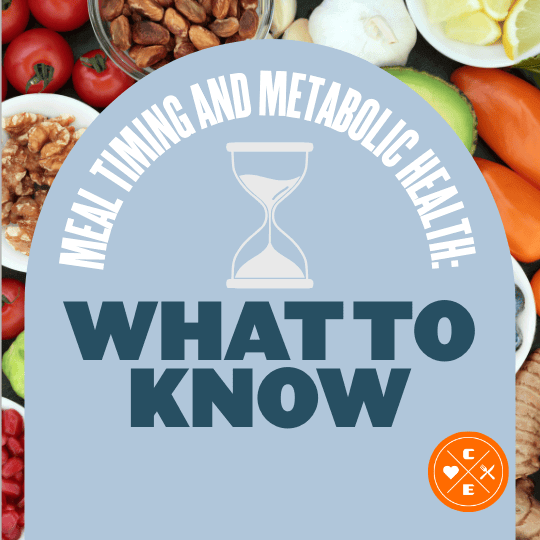Meal Timing and Metabolic Health: What to Know

Jason Nista
Nutrition
05/30/2025 8:41am
18 minute read
Table of Contents
- How to time your meals & optimize metabolism: Courtney Peterson, Ph.D. | mbg Podcast
- How Your Body Clock Controls Metabolism
- Best Meal Timing for Better Metabolic Health
- Time-Restricted Eating: A Simple Method
- How to Start Timing Your Meals Better
- Conclusion: Why Meal Timing Matters for Your Health
- FAQs
- FAQs
When you eat matters as much as what you eat. Studies show that eating earlier in the day aligns with your body’s natural rhythms, helping with weight loss, blood sugar control, and overall metabolic health. Late-night eating, on the other hand, disrupts your metabolism and can lead to weight gain, type 2 diabetes, and other health risks.
Key Takeaways:
- Eat earlier in the day: Your body processes food more efficiently in the morning and early afternoon.
- Avoid late-night eating: Insulin sensitivity drops in the evening, leading to poor glucose control and fat storage.
- Time-restricted eating (TRE): Limit meals to a specific window, like 8-10 hours, for better metabolic health.
- Best schedule: Have breakfast within an hour of waking, eat lunch 4-5 hours later, and finish dinner 2-3 hours before bed.
These small changes can improve your metabolism, energy levels, and overall health. Let’s dive into how your body clock impacts metabolism and why timing your meals can make a big difference.
How to time your meals & optimize metabolism: Courtney Peterson, Ph.D. | mbg Podcast
How Your Body Clock Controls Metabolism
Your body’s internal 24-hour clock plays a central role in regulating key metabolic functions, including when you burn fat, process glucose, and release hormones that influence hunger and energy storage. This internal schedule ensures that your metabolism operates efficiently, aligning with your natural circadian rhythms.
"The circadian system orchestrates metabolism in daily 24-hour cycles... Such rhythms organize metabolism by temporally separating opposing metabolic processes and by anticipating recurring feeding-fasting cycles to increase metabolic efficiency." [3]
At the heart of this system is a master clock located in the brain's suprachiasmatic nucleus (SCN). This clock works in harmony with peripheral clocks in various tissues, such as the liver, muscles, fat, and pancreas. Interestingly, about 10% of genetic transcripts follow these circadian patterns, meaning thousands of genes are activated or deactivated at specific times daily to support optimal metabolic function [3].
How Circadian Rhythms Impact Your Metabolic Health
Your body's ability to regulate glucose and secrete key hormones operates on a strict circadian schedule. For example, insulin peaks around 5:00 p.m., ghrelin rises before meals to signal hunger, leptin reaches its highest levels at night to promote satiety, and adiponectin peaks between noon and 2:00 p.m. Research has shown that glucose tolerance can vary significantly throughout the day. In prediabetic adults, oral glucose tolerance was 40 mg/dl higher at 7:00 p.m. compared to 7:00 a.m., while insulin sensitivity dropped by 34% from morning to evening [3].
Energy expenditure also fluctuates throughout the day. Metabolism is most active between 9:00 a.m. and noon, with a 17% difference between its peak and lowest levels. Conversely, metabolism slows to its lowest point between midnight and 6:00 a.m. Fat metabolism is particularly impacted by these rhythms, with triglyceride levels fluctuating by 33–63% over a 24-hour period. Notably, 80% of rhythmic metabolites in the blood are lipid-related compounds [3].
What Happens When You Eat at the Wrong Times
Eating during your biological nighttime can disrupt your body’s ability to process nutrients effectively, throwing off its finely tuned schedule.
"It is well known, albeit poorly understood, that insults to the body clock are going to be insults to metabolism." - Dr. Joseph T. Bass, Charles F. Kettering Professor of Medicine at Northwestern University Feinberg School of Medicine [5]
A study involving 14 healthy participants revealed that eating during the biological nighttime reduced total daily energy expenditure by about 3% on each night shift day [6]. Over time, this misalignment can lead to a harmful cycle. For example, animals that become obese often eat more during their rest periods, further disrupting their metabolism and complicating weight management [5].
Late-night eating also affects how organs like the pancreas, liver, and fat tissue process nutrients. These organs have their own circadian clocks, which are programmed to expect food at specific times. When food arrives outside those expected windows, the production of crucial enzymes and hormones may drop, leading to poor glucose control and increased fat storage [4].
Irregular meal timing can also confuse hunger and satiety signals. For instance, shift work often disrupts the normal ghrelin cycle, which can lead to overeating. This disruption creates a metabolic environment that encourages weight gain and raises the risk of type 2 diabetes and metabolic syndrome. Aligning your meal schedule with your body clock is essential for maintaining metabolic health.
Best Meal Timing for Better Metabolic Health
When it comes to maintaining metabolic health, the timing of your meals can be just as influential as the foods you choose. Research suggests that syncing your eating habits with your body’s natural rhythms can help with weight control, blood sugar management, and overall metabolic efficiency by working alongside your circadian clock.
Why Eating Earlier in the Day Matters
Your body is better equipped to process nutrients during the morning and early afternoon. Studies consistently highlight the benefits of consuming the majority of your calories earlier in the day.
"Eating earlier may be optimal because it coincides with greater insulin sensitivity and levels of these hormones and proteins, which together promote optimal metabolic function." [8]
For instance, a 2022 study in Obesity Reviews revealed that individuals who consumed most of their calories earlier in the day experienced greater weight loss and improvements in blood sugar, cholesterol, and insulin sensitivity compared to those who ate later [1].
Additionally, delaying your first meal of the day can have measurable effects. Research shows that for every hour you postpone eating, glucose levels rise by about 0.6%, and insulin resistance (measured through HOMA-IR) increases by 3% [8]. Nutritionist Audra Wilson, MS, RDN, CSOWM, CSCS, suggests a structured eating schedule to optimize metabolic health: have breakfast within an hour of waking, eat lunch four to five hours later, and maintain a similar gap between lunch and dinner [9]. She emphasizes, "Your body needs energy in the morning, so fuel it accordingly" [9]. To enhance these benefits, aim for 25–30 grams of protein at breakfast and prioritize calorie intake during breakfast and lunch, keeping dinner lighter [1].
On the flip side, eating late in the evening can counteract these advantages.
The Downsides of Late-Night Eating
Late-night meals can throw off your metabolic rhythm and hinder your health goals. Consuming over 45% of your daily calories after 5:00 p.m. has been linked to higher risks of type 2 diabetes, cardiovascular issues, and chronic inflammation [7]. A 2023 study further confirmed that eating late disrupts the body’s natural clock, contributing to weight gain and other cardiometabolic problems [1].
This is because insulin sensitivity declines in the evening, making it harder for your body to manage glucose. As a result, late-night eating encourages fat storage and disrupts blood sugar regulation. To avoid these issues, aim to finish eating at least 2 to 3 hours before bedtime [1]. This gives your body enough time to process nutrients before entering its natural fasting and repair mode during sleep. If you need a late meal, focus on foods rich in protein and healthy fats while keeping carbohydrates to a minimum to reduce glucose spikes [1].
The takeaway is clear: when you eat is just as important as what you eat for maintaining optimal metabolic health.
sbb-itb-1989a25
Time-Restricted Eating: A Simple Method
Time-restricted eating (TRE) is a straightforward approach that focuses on limiting food intake to a specific daily window, helping improve metabolic health [11]. Unlike diets that emphasize what you eat, TRE zeroes in on when you eat. By doing so, it supports metabolic efficiency and gives your digestive system longer fasting periods, which can lead to several health benefits.
Research suggests that TRE naturally reduces energy intake by 10–30%. A review of 27 trials even reported weight loss ranging from 0.8% to 13% with no serious side effects. What makes it appealing is its flexibility - it can be tailored to fit your current eating habits, making it easier to stick with over time. Instead of focusing on food composition, TRE shifts the focus entirely to timing.
8-Hour vs 10-Hour vs 12-Hour Eating Windows
Different TRE windows can offer distinct benefits, depending on your goals and metabolic needs.
8-hour eating windows are particularly effective for blood sugar control. One study found that both early and late 8-hour TRE increased the time blood glucose stayed within normal levels by an average of 3.3% [14]. Dr. Joanne Bruno from NYU Langone Health explains:
"Our research shows that just one week of following this diet strategy reduces fluctuations in blood sugar levels and reduces the time that the blood sugar is elevated above normal levels. This suggests early time-restricted feeding may be a helpful strategy for those with prediabetes or obesity to keep their blood sugars in a normal range and prevent them from progressing to type 2 diabetes." [12]
10-hour eating windows strike a balance between flexibility and metabolic benefits. Studies in individuals with metabolic syndrome show that a 10-hour TRE plan can lead to reductions in body weight, waist circumference, blood pressure, total cholesterol, and LDL-C [13]. In one case, participants lost 3% of their body weight and saw an 11% drop in LDL-C - results that surpass the typical LDL-C reduction expected with a 5% weight loss. Another study found that a 12-week, 10-hour eating window (e.g., 8:00 AM to 6:00 PM) helped overweight adults with type 2 diabetes lower their Hemoglobin A1c levels and shed weight compared to a control group [15].
12-hour eating windows are the most flexible option and a great starting point for newcomers. While this approach has been studied less extensively, fasting for 12 hours still provides metabolic advantages by giving your body enough time to switch from using glucose to burning ketones for energy.
Dr. Kelly Bowden Davies from Manchester Metropolitan University highlights the simplicity of TRE:
"Many people find counting calories hard to stick to in the long term, but our study suggests that watching the clock may offer a simple way to improve blood sugar control in people at risk of type 2 diabetes, irrespective of when they have their 8-hour eating window, which warrants investigation in larger studies and over the longer term." [14]
How to Time Your Protein, Carbs, and Fats
To maximize the benefits of TRE, paying attention to how you distribute macronutrients within your eating window is key.
For protein, aim for a diet composed of 45–65% carbohydrates, 10–25% protein, and 20–35% fat. Timing protein intake around workouts is especially important for maintaining muscle mass and boosting metabolism. For those engaging in strength training, consuming protein with a small amount of carbohydrates before and after exercise can enhance muscle recovery and growth while reducing exercise-related muscle damage [16].
Carbohydrate timing also matters. Studies show that eating a larger portion of carbs at 10:00 PM, compared to 10:00 AM, leads to higher blood sugar spikes [16]. This highlights the benefit of eating most of your carbs earlier in the day. Opting for minimally processed carbs not only provides sustained energy but also supports glycogen replenishment when consumed before endurance activities [16].
Dietary fats, on the other hand, have minimal impact on blood sugar levels and can be distributed more flexibly throughout your eating window. A practical weight-loss strategy involves consuming 50–70% of your daily calories in the morning, 20% in the afternoon, and 10% in the evening. This aligns with natural patterns of insulin sensitivity [16]. Additionally, spacing meals or snacks every 3–4 hours can help stabilize blood sugar levels. Avoiding heavy meals close to bedtime - about three to four hours before sleeping - can also improve digestion and sleep quality [16].
Jesse Oswald, a nutrition expert, sums it up well:
"Meal timing is the strategic scheduling of eating whole foods, fortified foods, and dietary supplements." [16]
How to Start Timing Your Meals Better
Making small changes to align your meal times with your body's natural rhythms can boost your metabolic health. The trick is finding a routine that works well with your lifestyle while respecting your internal clock. A great way to stick to a schedule is by incorporating pre-made meals into your plan.
Using Pre-Made Meals for Consistent Timing
One of the toughest parts of keeping a consistent eating schedule is the unpredictability of cooking. After a long day, the time it takes to prepare meals can delay or even cause you to skip eating altogether. This is where pre-made meals can make a big difference.
Studies show that meal prepping can help with weight management and reduce impulsive food choices [17]. Having ready-to-eat, portion-controlled meals on hand keeps you on track with your planned schedule. Basheerah Enahora, RDN, and owner of BE Nutrition, highlights the benefits of planning ahead:
"When we put some thought into it, we're more likely to pick up really nutrient-rich foods from the grocery store. We have a list that's decided in advance." [17]
Pre-made meals also help you avoid the temptation of high-calorie takeout. When you're hungry and short on time, having a healthy meal that’s ready in minutes makes it easier to stick to both your timing and nutrition goals.
Take Clean Eatz Kitchen as an example. Their chef-prepared meals are portioned for specific needs - like weight loss (under 600 calories per meal) or balanced nutrition - and are frozen for freshness. These meals can be microwaved in minutes, helping you maintain a consistent eating schedule, even on your busiest days.
If you’re new to meal prepping, start small. Plan dinners for 2–3 days at a time. Pick a day for menu planning, grocery shopping, and prepping. As Enahora advises:
"People feel that a meal plan has to be this rigid structure, but it doesn't necessarily have to be that. Choose a prep day that works for you, or spread the work out however makes the most sense for your schedule. Flexibility is key." [17]
In one study, participants who spent Sundays prepping weekday lunches and dinners for six weeks not only improved their diets but also lost an average of more than 3 pounds by the end of the program [17].
Setting Up a Daylight-Based Meal Schedule
In addition to prepping meals, syncing your eating schedule with daylight hours can strengthen your body’s natural rhythms. Your metabolism is most active during the day, so eating within this window can support overall health [19].
Start by eating within two hours of waking up [18]. This first meal breaks your overnight fast and jumpstarts your metabolism for the day. It doesn’t need to be complicated - something as simple as a piece of fruit with nuts or a protein smoothie works.
From there, aim to eat every three to four hours [18]. Each meal should include protein, high-fiber starches, vegetables, fruits, and healthy fats [18] to keep your energy steady and hunger in check.
The ideal eating window aligns with daylight. Johns Hopkins Medicine suggests:
"Remember that your body operates on a 24-hour clock but food is best consumed starting in the morning to the early evening hours which are 5:00-7:00 PM for optimal health!" [2]
Here’s a sample daylight-based schedule:
- 7:00 AM – 8:00 AM: First meal within two hours of waking
- 11:00 AM – 12:00 PM: Mid-day meal (3–4 hours later)
- 3:00 PM – 4:00 PM: Afternoon meal or hearty snack
- 6:00 PM – 7:00 PM: Final meal of the day
Focus on having a hearty breakfast to start your day and gradually reduce meal sizes as the day progresses [19]. Try to finish eating 2–3 hours before bedtime to support better sleep and digestion.
While consistency is important, don’t stress over occasional deviations. Mild variability in mealtimes is normal [18]. Stick to your schedule as much as possible, but allow for flexibility on special occasions or when life gets in the way [1].
Above all, listen to your body. Pay attention to hunger cues and adjust your schedule based on what feels best for your energy and appetite [18]. And don’t forget to stay hydrated throughout the day - it’s essential for digestion and keeping hunger in check [1].
Conclusion: Why Meal Timing Matters for Your Health
What you eat is important, but when you eat can have just as much impact on your health. Your body runs on an internal clock, anticipating food during the day and rest at night. Aligning your meals with these natural rhythms can help improve your metabolism and support overall well-being.
Studies have shown that eating more of your calories earlier in the day can lead to noticeable weight loss benefits [21]. On the other hand, glucose tolerance and insulin sensitivity drop in the evening, which can result in higher blood sugar spikes and an increased risk of developing type 2 diabetes over time [10][21].
The good news? Making small, consistent changes to your meal timing can make a big difference. For example, starting your day with a breakfast rich in protein - around 25–30 grams - and finishing your last meal 2–3 hours before bed can help you stay in sync with your body’s natural rhythms. This synchronization between your central and peripheral body clocks plays a key role in keeping your metabolism functioning at its best [20].
Routine is crucial here. While it’s fine to be flexible occasionally, your body thrives on consistency. If sticking to a regular eating schedule feels overwhelming, meal services like Clean Eatz Kitchen can simplify things by offering chef-prepared, portion-controlled meals that fit into a circadian-friendly routine.
Eating meals during daylight hours - from sunrise to sunset - helps strengthen your body’s natural rhythms and creates a positive cycle for metabolic health [20]. By aligning your eating habits with the sun’s schedule, you’re not just boosting your metabolism - you’re also improving your energy levels, sleep quality, and overall quality of life.
FAQs
How does the timing of meals affect blood sugar and insulin levels?
The timing of your meals can significantly impact blood sugar and insulin levels. Studies suggest that having breakfast earlier in the day - ideally before 8:30 AM - can enhance insulin sensitivity and promote steadier glucose levels. In contrast, eating late at night has been linked to increased insulin resistance and more pronounced blood sugar swings.
Evening meals, in particular, tend to cause sharper glucose spikes and make insulin less effective. By aligning your eating habits with your body’s natural circadian rhythms - such as prioritizing larger meals earlier in the day - you can support better metabolic health and maintain more consistent glucose control.
What are the benefits of time-restricted eating, and how can I make it work for me?
Time-restricted eating (TRE) is a straightforward way to support metabolic health, helping with blood sugar levels, weight management, and heart health. Studies also point to potential perks like better sleep, improved gut health, and a boost in overall well-being by syncing your eating habits with your body’s natural clock.
To try TRE, pick an eating window that fits your lifestyle - say, 10 AM to 6 PM or 12 PM to 8 PM. Eat your meals and snacks during this time, then fast for the rest of the day. While fasting, stay hydrated with water, black coffee, or tea without any added calories. It’s a simple shift that can not only improve your health but also make your daily routine more manageable.
Why is it important to eat meals in sync with your body's natural rhythms, and what are the risks of eating late at night?
Eating meals in sync with your body's circadian rhythms - its natural 24-hour clock - can play a big role in boosting metabolic health. When your eating schedule aligns with these rhythms, your body becomes better at processing nutrients, maintaining steady blood sugar levels, and balancing hormones like cortisol and leptin. This harmony can support weight management and improve overall health.
In contrast, eating late at night can throw off these rhythms. It slows down your metabolism, encourages fat storage, and disrupts blood sugar regulation. Over time, this pattern may raise the likelihood of developing conditions such as obesity, type 2 diabetes, and heart disease. Choosing to eat earlier in the day, during daylight hours, helps keep your body in sync and functioning optimally.
Related Articles
Carbs vs. Protein: Best Pre-Workout Energy Source
17 minute read
Ultimate Guide to Adaptogens for Gut-Brain Balance
13 minute read
Carb Periodization: Off-Season vs. Peak Training
16 minute read


